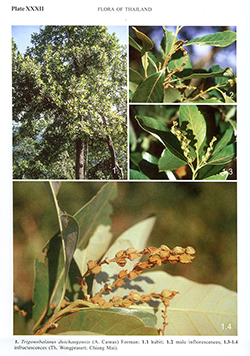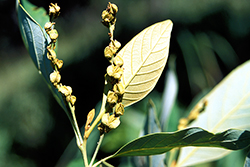e-Flora of Thailand
Volume 9 > Part 3 > Year 2008 > Page 409 > Fagaceae > Trigonobalanus
Trigonobalanus doichangensis (A.Camus) Formanwfo-0000328176
Kew Bull. 17, 1964: 387.— Quercus doichangensis A.Camus, Bull. Soc. Bot. France 80: 335. 1933.— Formanodendron doichangensis (A.Camus) Nixon & Crepet, Amer. J. Bot. 76: 840. 1989; C.C.Huang, Y.T.Chang & B.M.Bartol. in C.Y.Wu & P.H.Raven, Fl. China 4: 370. 1999. Fig. 131; Plate XXXII.
Accepted Name : This is currently accepted.
Synonyms & Citations :
Description : Tree, 15–30 m high, 100–200 cm girth. Bark brown to dark brown; outer part scaly, inner part with fine long and narrowed ridge, always depressed; sapwood as narrow canals. Interpetiolar stipules narrowly triangular, ca 3 by 1 mm. Leaves elliptic to more or less obovate, 6–12 by 2–5.5 cm; base cuneate; apex acute; subcoriaceous, green and shiny on the upper surface; pale on the lower; midrib prominent on the lower surface, lateral nerves 10–15 pairs, finely ridged on the lower; scalariform veins distinct on the lower surface. Petiole 0.5–1.5 cm long, glabrous, flat at adaxial, petiole and midrib pinkish when dry. Male inflorescences suberect, 3–10 cm long, puberulous throughout. Male flowers sessile, perianth campanulate, 6 lobed, free or minutely connate near base; stamens 6; anthers ovoid, basifixed; rudimentary ovary a cluster of hairs. Female inflorescences catkin erect, perianth as male, adnate to ovary at base; staminodes 6; styles 3, decurved or connate near base; stigmata capitate. Cupule sessile, broadly saucer-shaped, ca 1 cm in diam., with 7 or more irregular lobes, all covered with brown hairs, glabrescent, normally bearing 1–3 nuts. Nut prominently longitudinally triangular ridged, 5–10 by 6 mm (young), densely, brown hairs then glabrous and shiny.
Thailand : NORTHERN: Mae Hong Son, Chiang Mai.
Distribution : China (Yunnan).
Ecology : Uncommon, on hill ridges in lower montane rain forests, 900–1,600 m alt. Flowering and fruiting: December–February.
Vernacular : Ko doi chang (ก่อดอยช้าง), ko sam liam (ก่อสามเหลี่ยม)(Northern).
Notes: This species is rare and endangered to Thailand. Its seedlings are restricted in distribution; the acorns are always destroyed by fungi and insects.



